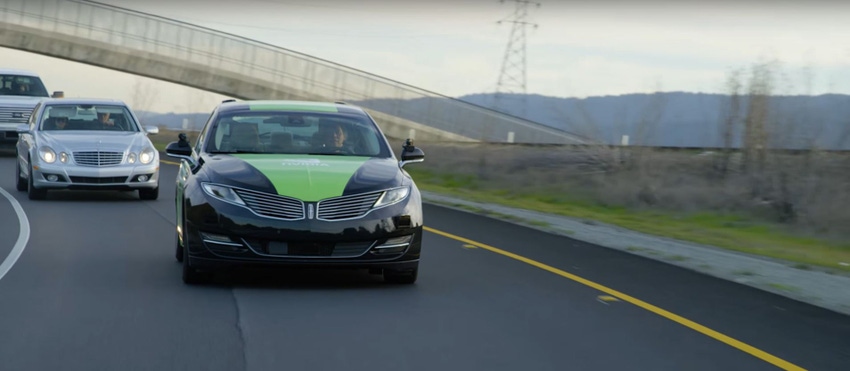A series of Nvidia announcements around AI and connected cars at CES underpin a ludicrous 12 months, in which its share value has surged by more than 200%.
January 6, 2017

A series of Nvidia announcements around AI and connected cars at CES underpin a ludicrous 12 months, in which its share value has surged by more than 200%.
The chip manufacturer, known for specialising in graphics processors, has made a significant series of movements this week, including a renewed partnership with Audi, a new AI “co-pilot” for drivers, and the reveal of its own driverless car.
Let’s start with the driverless car, because it’s the coolest. The car, colloquially dubbed “BB8” by Nvidia employees – something of an incongruent Star Wars reference – was revealed over in Las Vegas accompanied by a trendy video of a bloke desperate to embark on a humble mission to get a cup of coffee. Fortunately for our troubled adventurer, BB8 is on hand to drive him to the Starbucks in San Mateo. Whew.
Mission objective triviality aside, the video is really cool. It’s cool because it visualises the thought processes of the vehicle, which involves the capture and analysis of data from a whole bunch of sensors. It leans on the Drive PX2 system, which according to Nvidia fuses data from multiple cameras, as well as radar, ultrasonic sensors and lidar – whatever that is. In turn, algorithms try and make sense of the full 360-degree environment around the car.
To do so, it uses a LOT of artificial intelligence. Coincidentally, Nvidia worked in conjunction with transportation supplier ZF to develop an AI-driven self-driving system based on Drive PX2. Obviously, Nvidia was keen on it, saying that AI will be the tool to drag today’s automotive industry into the next generation.
“It’s not an exaggeration when we talk about artificial intelligence as the technology that will spark an industrial revolution,” said Rob Csongor, VP of Automotive at Nvidia. “Doing this requires a computational breakthrough and we now have that breakthrough in AI.”
In what was an action-packed reveal at CES, the connected cars section also featured an appearance from the head of Audi America, Scott Keogh, on the relationship between Audi and Nvidia. Keogh enthused about how Audi sales have leaped three-and-a-half-fold in the ten years they’ve been working together – although claiming vehicle sales are directly proportional to a computing partnership appears a little insincere to us.
All of these announcements cap off what’s been an extraordinary 12 months for Nvidia. For the past five years it has been relatively active in the connected car space with pre-runners to some of the aforementioned technologies. It has also been working heavily in the infotainment arena for the past two years, but a collaboration with TomTom in September last year to develop a mapping system for self-driving cars could be considered a watershed moment for the firm.
To put it into context, look at the chart below which illustrates how Nvidia’s share price has absolutely rocketed in the past 12 months.
Elsewhere at CES, LG continued the connected cars momentum being generated in Vegas by announcing a new in-car advanced driver assistant system. Separately it also launched its 65 or 77-inch model 4K TV which is so thin it has to be wall mounted. Quite how all the necessary plugs and connectors jack into a device that’s just a few millimetres thick is beyond us – but hey, at least LG’s 2017 CES offerings are a little more inspired than the “future of laundry” reveal they so proudly announced to a thoroughly underwhelmed audience a couple of years back. This is still the most cringe-worthy product reveal we’ve ever seen.
Ford has been partnering left, right and centre at CES this week, with Amazon and Samsung both getting into bed with the car maker. Amazon will be supplying Alexa voice UI functionality to new models, so Ford owners can access their car from home and call other features from their vehicle using Alexa.
As is typical for Amazon, the first problem solved by this is the ancient dilemma of constantly needing to shop, but vehicular imprisonment impeding your consumption objective. Well, thankfully we can now shop in our Ford cars using Alexa. Problem solved, and mid-transport retailing tragedies will soon be a thing of the past. Whew.
Additionally, Ford is integrating Sync (its own in-car system) with Samsung Gear S2 and S3, so the limited number of wearable owners out there can be given notifications by their car – handy for things like parking reminders and alerts.
Ford has also implemented high-speed in-car wifi hotspots into its 2017 models, powered by AT&T’s LTE service. The Sync Connect system can allow up to 10 connected devices in any one car. Considering the average Ford car seats five, including the driver who shouldn’t be using any devices while driving, the four remaining passengers can connect an average of 2.5 devices to the wifi network each. That’s insane usage, even for the millennial generation.
Finally, Mercedes has pledged allegiance to Google by collaborating on Google Assistant integration for its 2017 models. According to Merc, the early months of 2017 will see customers communicate with their cars through their ominously-entitled “Google Home”.
About the Author(s)
You May Also Like








.png?width=300&auto=webp&quality=80&disable=upscale)


_1.jpg?width=300&auto=webp&quality=80&disable=upscale)


.png?width=800&auto=webp&quality=80&disable=upscale)